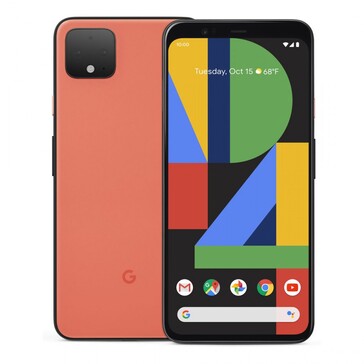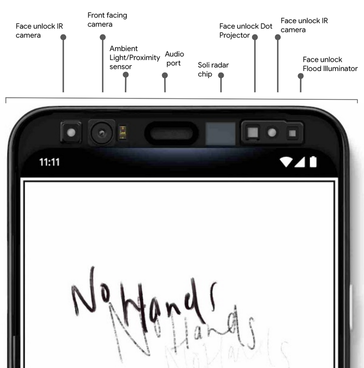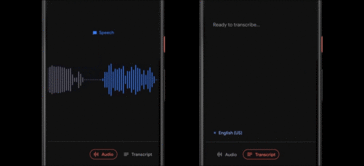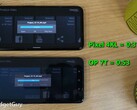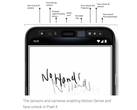After numerous rounds of leaks, the Google Pixel 4 and Pixel 4 XL are now finally official. Despite almost every feature of the device being leaked over the past few weeks, Google still had a lot to show off about the latest iterations to the Pixel series.
Display — 90 Hz OLED with HDR
Both the Pixel 4 and the Pixel 4 XL are nearly identical with the only difference between them being the screen size (5.7-inch FHD+ and 6.3-inch QHD+, respectively) and battery capacity (2,800 mAH and 3,700 mAH, respectively). High refresh rate screens are slowly becoming a norm in the Android world and both the Pixel 4 phones come with 90 Hz OLED screens (Google calls this Smooth Display) with no notches. With a higher refresh rate, the comparatively lower 2,800 mAH battery capacity does raise some eyebrows, but Google says that the screen only shifts to 90 Hz when needed and otherwise operates at 60 Hz to save power.
The screen is HDR capable and features an Ambient EQ mode that automatically adjusts screen colors to suit ambient light. You also get always-on notifications, a full 24-bit color depth, and a 100,000:1 contrast ratio. Google said that the Pixel 4 XL's display has received an A+ rating from DisplayMate.
Camera — 12 + 16 MP setup with added software magic
Google also spoke a lot about the cameras and how software can help get the best out of the hardware. The Pixel 4 offers a dual-camera setup. The primary shooter is a 12 MP lens with a 1.4-micron pixel size, f/1.7 aperture, dual-pixel autofocus, and OIS/EIS support. New to the Pixel lineup is a 16 MP telephoto lens with a 1.0-micron pixel size and OIS/EIS support. There is no ultrawide angle lens, however. Instead, the Pixel 4 comes with a spectral+flicker sensor to help in scenes with strobing lights.
The Pixel lineup is known for excellence in smartphone photography and the GCam app is often used by users of non-Google phones as well. Continuing the tradition, the Pixel 4 offers a Neural Core that makes use of on-device AI to give some stunning results. The camera app can now render HDR in real-time so you can directly decide on the highlights and shadows in the viewfinder itself. Although the telephoto lens does not exactly offer a 2x focal length, Super Resolution Zoom enables direct zooming in the viewfinder to more than 2x zoom instead of having to resort to cropping later.
Video recording on the rear cameras is supported up to 4K 30 fps. An 8 MP selfie camera with a 3D depth sensor enables instant face unlocks, bokehs in selfies, and FHD 30 fps video recording. There is no fingerprint reader on the Pixel 4.
Motion Sense — A real radar in your pocket
Hands-free usage just got a whole lot cooler thanks to the Soli radar chip in the Pixel 4. The radar is more accurate than an optical setup and allows for more complex gestures. Now, with a wave of your hand, you can answer or decline calls, switch music tracks, and control UI navigation. The radar is intelligent enough to recognize a real gesture from say, moving an object above the phone.
Improved Google Assistant and voice recognition
Google is introducing an updated version of Google Assistant with the Pixel 4 that does a better job at voice recognition, photo identification, and on-device speech processing. The voice recognition is fairly advanced and can do a live transcription of speech, which can be saved and indexed for searching keywords — and you don't even need to be online to do this. Sensitive data is protected on the device by a dedicated Titan M security chip.
SoC — Snpadragon 855 minus the Plus
Both the Pixel 4 and the Pixel 4 XL are powered by the Qualcomm Snapdragon 855. There is no 855 Plus, but that shouldn't make too much of a difference in the real world. There is 6 GB of RAM onboard — up from the somewhat lower 4 GB on the Pixel 3, and 64 GB and 128 GB storage options. (Google Pixel 3 64GB on sale now at Amazon)
The battery capacity of the Pixel 4 is somewhat on the lower side. Thankfully, Google bundles an 18W USB-Type C fast-charger in the box.
Pricing and availability
The Pixel 4 and Pixel 4 XL will be available across all major US carries and can be pre-ordered today starting from US$799 and US$899, respectively in Clearly White, Just Black, and a limited edition Oh So Orange color options. Buyers will also get three months of Google One service that offers Pro phone support and 100 GB of Google Drive storage. Shipping commences from October 24. (Google Pixel 3a 64GB on sale now at Amazon)
Source(s)
Made by Google 2019 Event





